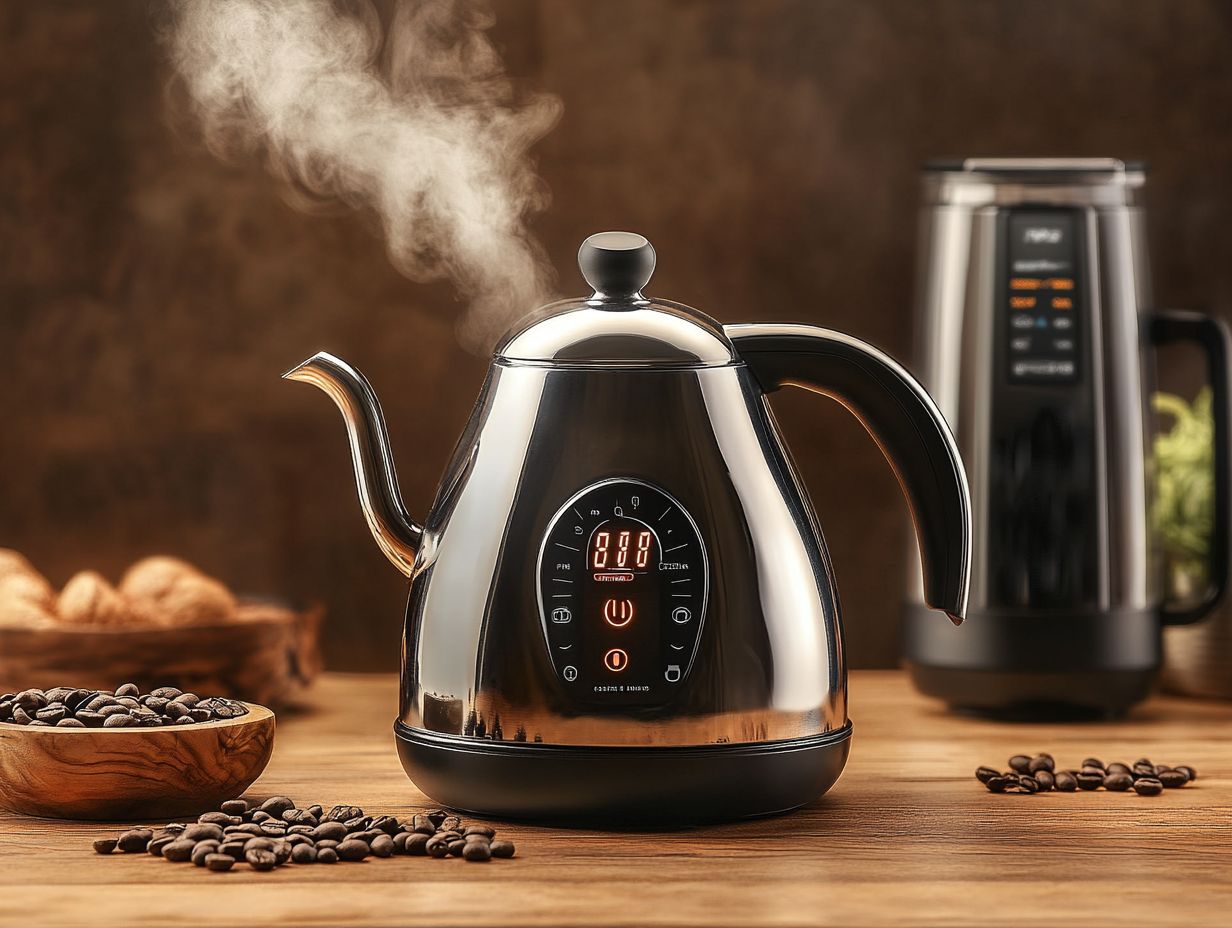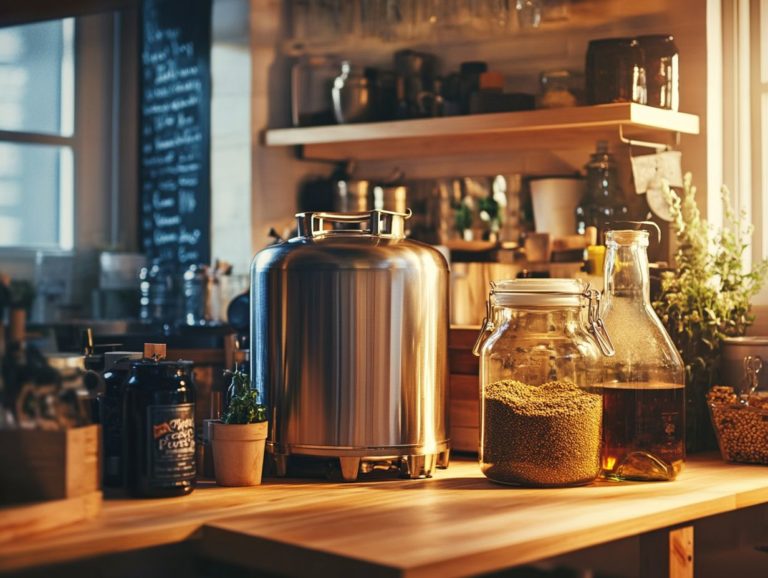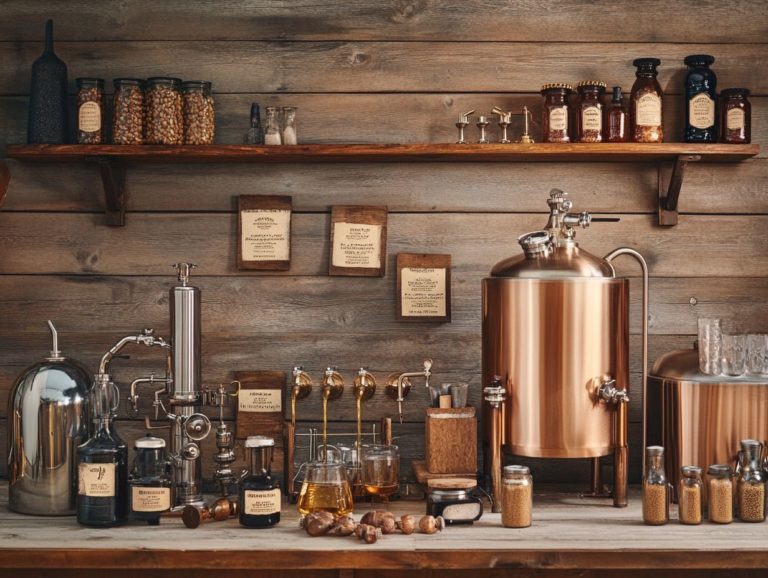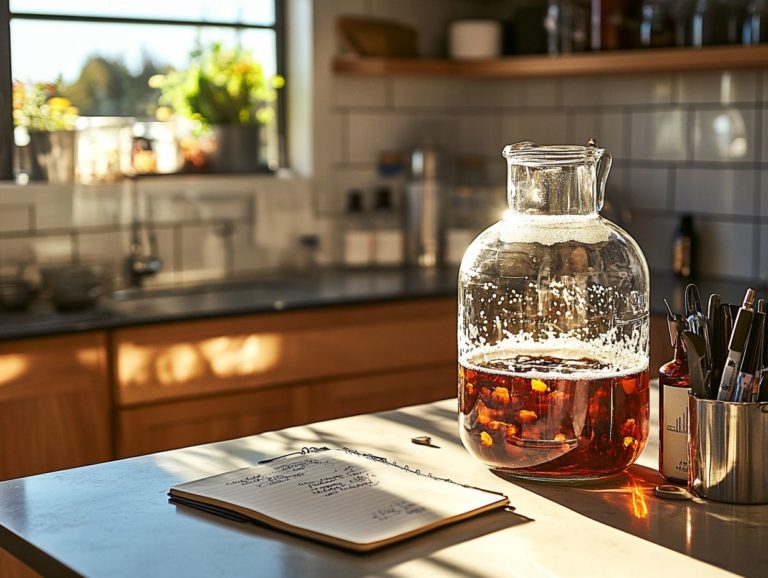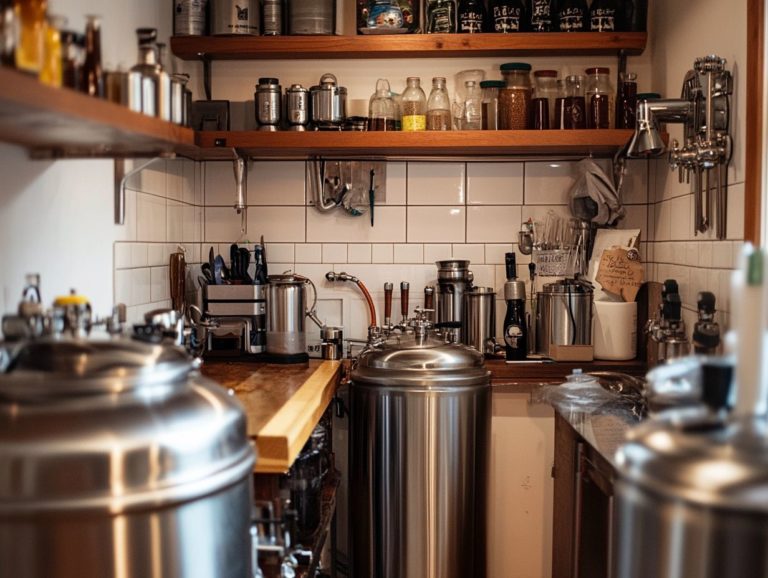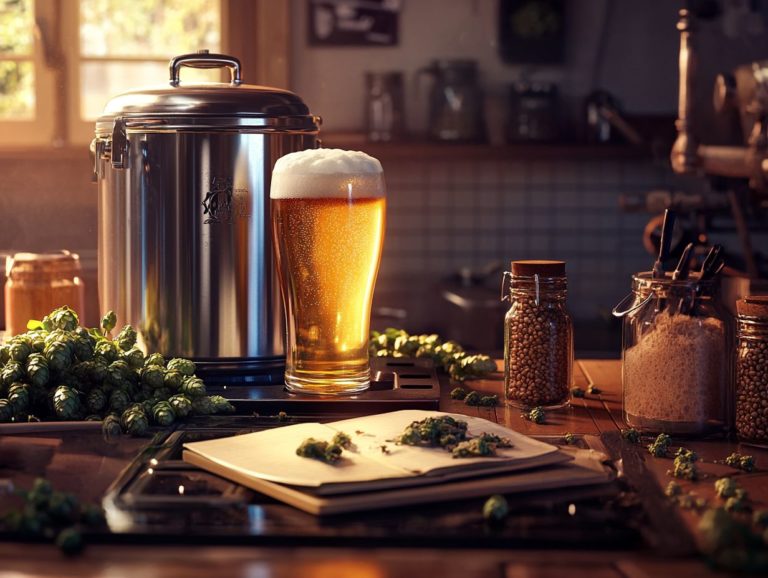How to Maintain Consistent Brewing Temperatures
Brewing the perfect cup of coffee, tea, or home-brewed beer requires more than simply selecting high-quality ingredients; maintaining a consistent temperature is absolutely essential. Even the slightest variation can significantly alter the flavor and aroma of your brew.
In this article, you ll discover the importance of keeping your brewing temperatures stable, along with the various factors that can influence them, such as ambient conditions, the equipment you use, and brewing tips from the brewing community. You ll also find practical tips for measuring and managing these temperatures, ensuring a delightful brewing experience each time.
Whether you re just starting out or you re a seasoned brewer, this guide is designed to elevate your beverage-making skills and provide valuable homebrewer advice to new heights.
Contents
- Key Takeaways:
- Why is Maintaining Consistent Brewing Temperatures Important?
- Factors Affecting Brewing Temperatures
- Factors Affecting Brewing Process
- How to Measure Brewing Temperatures?
- How to Maintain Consistent Brewing Temperatures
- How to Maintain Consistent Brewing Temperatures?
- Tips for Maintaining Consistent Brewing Temperatures
- 4. Clean and Maintain Brewing Equipment Regularly
- Frequently Asked Questions
- What is the importance of maintaining consistent brewing temperatures?
- What are some factors that can affect brewing temperatures for home brewing?
- How can I monitor and control brewing temperatures in my fermentation environment?
- What are some techniques for maintaining consistent brewing temperatures during the fermentation process?
- What are the consequences of not maintaining consistent brewing temperatures?
- How often should I check and adjust brewing temperatures?
Key Takeaways:
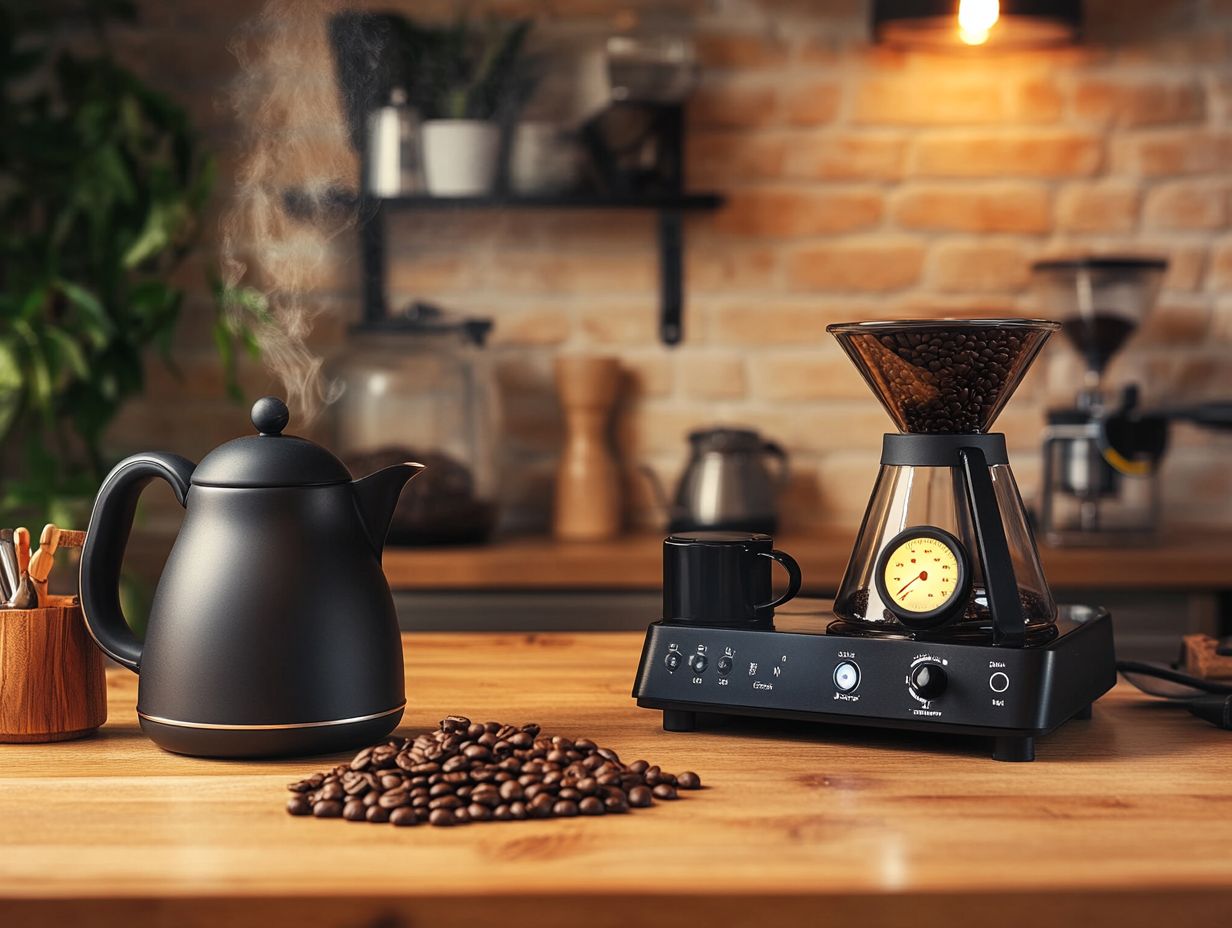
- Ensure consistent brewing temperatures to produce exceptional, repeatable results.
- Understand how factors like ambient temperature and humidity affect your brew.
- Employ effective methods to maintain temperature, such as preheating and using insulated equipment.
Why is Maintaining Consistent Brewing Temperatures Important?
Maintaining consistent brewing temperatures is essential in the fermentation process, as it profoundly influences the quality of the beer you brew. Different yeast strains respond uniquely to temperature fluctuations, which can lead to off-flavors or incomplete fermentation.
By carefully controlling the fermentation temperature, you can ensure that your first batch achieves the desired flavor profile and meets the highest quality standards. Proper temperature regulation elevates your overall brewing experience and minimizes unwelcome surprises during fermentation, making it a pivotal element of successful home brewing.
Using temperature control methods, such as a fermentation chamber or an aquarium heater, will dramatically enhance the consistency of your results, ensuring every brew is a success!
Factors Affecting Brewing Temperatures
Several factors can profoundly impact brewing temperatures, subsequently influencing both the fermentation process and the quality of your beer. Ambient temperature is particularly crucial; even slight fluctuations can result in inconsistent fermentation, ultimately affecting yeast performance.
Moreover, humidity levels can change how heat is retained within your brewing equipment. The choice of equipment whether fermentation chambers, insulated blankets, or a DIY brew setup using a rubbermaid tub can also play a significant role in maintaining temperature consistency.
Grasping these elements is essential for you as a home brewer aiming to refine your brewing techniques and achieve exceptional results in your beer creations. Be sure to join a brewing community to exchange fermentation tips and brewing hacks.
Join a brewing community today or subscribe for more tips to take your brewing skills to the next level!
Factors Affecting Brewing Process
1. Ambient Temperature
Ambient temperature plays a pivotal role in the brewing process. It significantly impacts the fermentation environment where yeast works its wonders.
When ambient temperatures fluctuate, you risk inconsistent fermentation rates. This can ultimately affect the flavor and quality of your final product. Simple measures like using ice packs or a wet towel can help maintain a stable temperature.
As a home brewer, your goal should be to create a stable fermentation environment by closely monitoring these temperatures. Employing temperature control methods, such as fermentation chambers or insulated blankets, can help you maintain ideal conditions.
Yeast is particularly sensitive to temperature variations. Higher temperatures can increase yeast activity, possibly leading to off-flavors or too much fizz. Lower temperatures may slow fermentation, resulting in beers that are not fully fermented. It s essential to grasp the importance of maintaining a consistent temperature range typically between 65 F to 75 F for most ales as this can greatly enhance the development of desirable flavors.
Using a swamp cooler or cold crashing methods can help in certain situations where temperature control is challenging. To achieve stability, consider utilizing tools like thermostats, temperature sensors, or simple water baths to create an optimal brewing environment.
Employing an aquarium heater in your water bath can provide consistent heat. By implementing these techniques, you can ensure a robust fermentation process and produce a high-quality brew that truly showcases the full potential of your ingredients.
2. Humidity
Just as temperature plays a critical role, humidity also significantly affects your brewing environment. Humidity influences brewing temperatures, as it directly impacts how effectively heat is retained within your brewing equipment, especially in fermentation chambers.
When humidity levels soar, you may encounter increased condensation. This can hinder the efficiency of your equipment and complicate your temperature control efforts.
On the flip side, low humidity can lead to rapid temperature fluctuations, potentially harming yeast performance during fermentation. Consider your humidity levels carefully to ensure your brew turns out perfectly!
Maintaining optimal humidity levels is vital for creating a stable brewing environment. Fluctuations can lead to inconsistent fermentation results. For the best fermentation outcomes, utilizing humidity controllers alongside temperature regulators is a smart strategy.
Establishing a climate-controlled space be it a dedicated brewing room or an enhanced fermentation chamber will help minimize the effects of external weather changes. Consider investing in a used refrigerator converted into a fermentation chamber, which can provide excellent control over both temperature and humidity.
Monitoring moisture levels with hygrometers provides invaluable insights. This ensures your brewing equipment operates efficiently and that your yeast remains active, leading to a robust and flavorful final product. A well-structured approach to humidity control is essential for anyone like you who aims for quality and consistency in brewing.
3. Altitude
Brewing at high altitudes? Get ready for an adventure! Altitude can profoundly influence fermentation temperature and the overall brewing process, as the relationships between pressure and temperature shift with elevation. At higher altitudes, water boils at lower temperatures, which significantly affects your brewing techniques and makes temperature management all the more critical.
This is particularly important in DIY brew projects where precise control might be limited. As a home brewer at elevated altitudes, you’ll likely need to tweak your fermentation temperatures and techniques to maintain the quality of your beer and achieve those desired flavor profiles.
If you re brewing at elevations above 5,000 feet, remember that the typical boiling point of water decreases. These adjustments are not just helpful they’re essential to ensure your beer reaches perfection! This decrease necessitates adjustments in your the temperature at which you mix malt and water to extract sugars.
Techniques such as extending the boil time or using increased pressure brewing equipment can help you navigate these challenges. Adjusting how much yeast you add and fermentation temperatures is vital for ensuring that flavors develop as they should. Using a brew belt or an electric heater can also help maintain consistent temperatures in such conditions.
By keeping an eye on local weather patterns and making seasonal adjustments, you can refine your brewing process, ultimately leading to richer, more balanced brews that truly capture the essence of your high-altitude environment.
4. Brewing Equipment
Temperature Control Solutions
The type of brewing equipment you choose plays a crucial role in maintaining the perfect temperatures throughout the brewing and fermentation process. Investing in equipment like a kegerator or keezer helps regulate and maintain temperature control during brewing and storage.
For example, using fermentation chambers specifically designed for craft brewing can create a controlled environment that minimizes temperature fluctuations. This ensures that yeast activity stays consistent.
Electric heaters or heating belts become invaluable during the cooler months, warming fermentation vessels to prevent sluggish fermentation, which can lead to undesirable off-flavors. Kegerators not only serve as storage for your finished beer but also allow you to regulate temperature accurately while serving.
This preserves the unique characteristics of each brew. Using tools like a digital temperature controller can provide precise temperature adjustments. This variety of equipment highlights the importance of customizing your setup according to your brewing method.
Techniques like lagers or ales may require different temperature profiles to truly enhance flavor development and clarity.
How to Measure Brewing Temperatures?
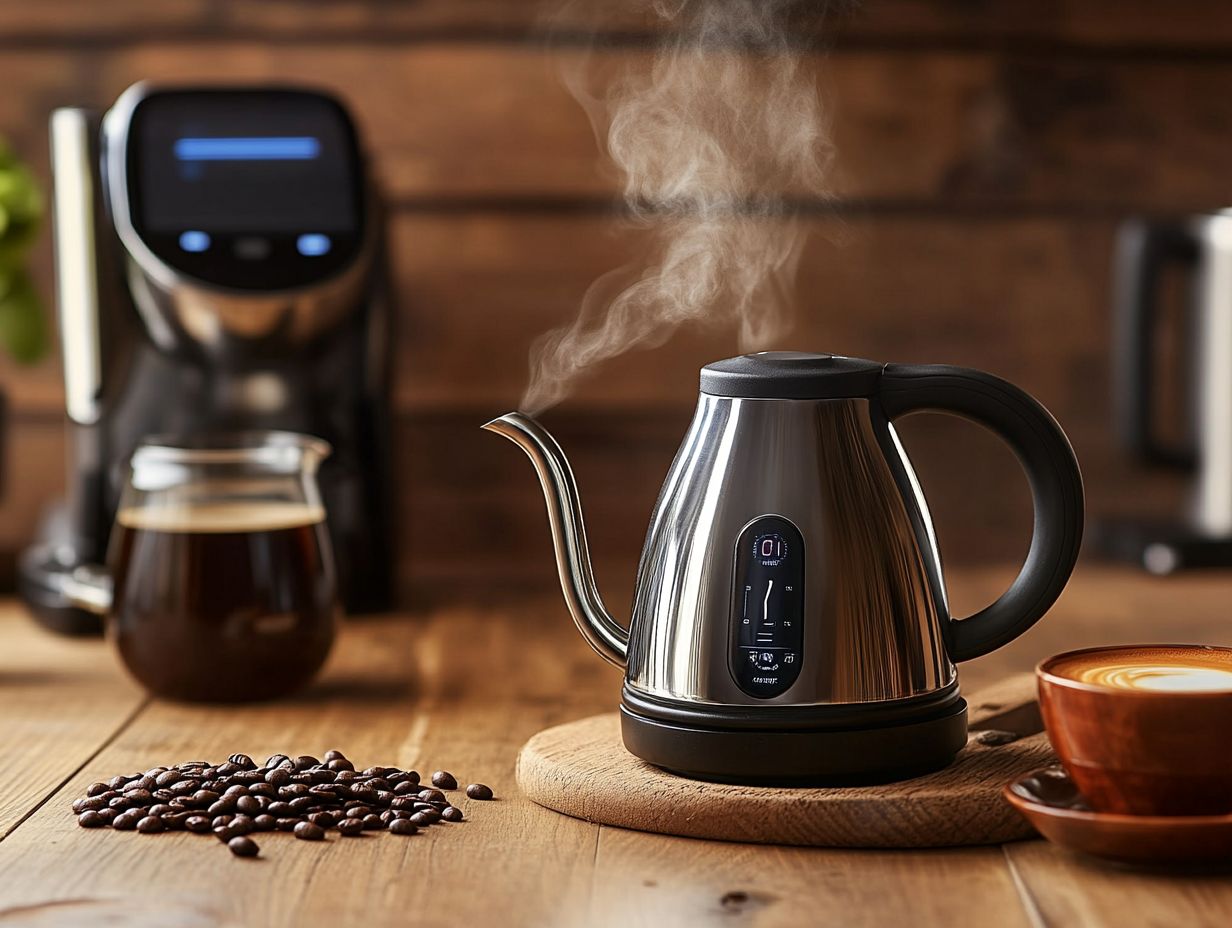
Accurately measuring brewing temperatures is crucial for the success of your fermentation process and for enhancing the quality of your beer. You have a range of tools and methods at your disposal for this task, from traditional thermometers to temperature-controlled kettles and sophisticated brewing systems that come with built-in sensors.
Using a combination of brewing equipment and temperature control tools like a fermentation heater can help to maintain optimal conditions throughout the process. Each of these instruments offers valuable insights into your fermentation environment, giving you the power to make essential adjustments and maintain optimal conditions throughout your brewing journey.
1. Using a Thermometer, Brew Belt, or Digital Thermometer
A traditional thermometer stands as one of the simplest yet most effective tools for measuring brewing temperatures, giving you the power to achieve precise readings during the fermentation process. By routinely checking the temperature of your wort or fermentation area, you can swiftly identify any deviations from your desired range and make necessary adjustments.
Utilizing a thermometer helps maintain optimal fermentation conditions and enhances the overall quality of your beer. Using a brew belt or digital thermometer also provides more consistent results.
You ll find a variety of thermometers available, including digital, analog, and infrared models, each offering distinct advantages in terms of accuracy and user-friendliness. Digital thermometers often provide instant readings, while analog models may give you a more tactile sense of temperature changes. Aim for a thermometer that allows readings in both Celsius and Fahrenheit to maximize versatility.
Other temperature control tools, such as frozen water bottles or a heating belt, can be used alongside these thermometers for more stable results.
Incorporating regular temperature monitoring into your brewing routine is essential. This could mean establishing a set schedule or conducting visual checks throughout the process. Maintaining consistent temperatures fosters yeast activity and fermentation efficiency, ensuring your final product achieves the desired flavor profile and aroma.
Regardless of whether you opt for a straightforward traditional model or a sophisticated digital version, prioritizing accurate temperature measurement can profoundly enhance your brewing experience.
2. Using a Temperature-Controlled Kettle
Using a temperature-controlled kettle is a game changer for precise temperature management during your brewing process, a crucial factor for optimal fermentation and superior beer quality. These advanced tools allow you to set and maintain specific temperatures, minimizing the risk of overheating or undercooking your ingredients.
By stabilizing brewing temperatures, you can enhance the efficiency of fermentation and achieve consistent results with every batch. This level of precision is particularly handy when crafting different styles of beer, as each type often requires its unique temperature profile to highlight distinct flavors and aromas.
For instance, lagers generally ferment best at cooler temperatures, while ales flourish in warmer conditions. With a temperature-controlled kettle, you can attain your desired flavor profile and avoid the off-flavors that improper fermentation temperatures can produce.
Ultimately, using specialized equipment boosts the quality of your final product and opens the door to experimenting with a wider array of recipes, leading to a more enjoyable and rewarding brewing experience.
3. Using a Temperature-Controlled Brewing System
A temperature-controlled brewing system offers you an integrated way to manage brewing temperatures throughout the entire fermentation process, ensuring that your yeast thrives under optimal conditions. With advanced features like real-time temperature monitoring and automated adjustments, these systems are crafted to enhance your brewing consistency and quality control.
As a home brewer utilizing such technology, you can achieve exceptional results with minimal effort, allowing you to devote your attention to other important aspects of the brewing process.
This innovative technology enables precise temperature regulation, essential for yeast activity, which can dramatically influence the final flavor profile of your brew. By maintaining temperatures within a specified range automatically, you can steer clear of the temperature fluctuations that often lead to off-flavors or stalled fermentation.
Many systems are designed with user-friendly interfaces, making them accessible even for those just starting their brewing journey. The precise control these systems provide not only boosts fermentation efficiency but also aids in replicating successful brews, paving the way for improved quality and an overall more enjoyable brewing experience.
How to Maintain Consistent Brewing Temperatures
How to Maintain Consistent Brewing Temperatures?
To maintain consistent brewing temperatures, you need an active approach involving careful monitoring and the strategic use of insulated equipment. As a home brewer, it’s essential to be diligent in observing your brewing environment. Make adjustments to handle temperature changes that may arise, ensuring a smooth fermentation process.
By implementing effective methods to control ambient temperature and employing insulated equipment, you can significantly improve your ability to maintain ideal fermentation conditions, ultimately enhancing the quality of your beer.
1. Preheat Equipment
Preheating your equipment is a crucial step in achieving consistent brewing temperatures. It helps stabilize the environment before fermentation kicks off. By ensuring that your fermentation chambers or brewing kettles are at the correct temperature before you dive in, you can minimize heat loss and create a more controlled environment for fermentation.
This practice enhances yeast activity and significantly improves the overall quality of the beer you produce.
There are various approaches to preheating different types of brewing equipment. For example, when working with stainless steel kettles, you can briefly pour warm water inside before brewing. If you’re using glass carboys, gently warming them with a heat wrap can help you reach those optimal temperatures.
These steps are essential because they prevent drastic temperature fluctuations that could stress your yeast. By maintaining ideal fermentation temperatures, you’ll encourage the development of desirable flavors, ultimately elevating your beer’s quality.
Make preheating a regular part of your brewing routine. This not only fosters better fermentation but also leads to a superior final product.
2. Monitor and Adjust During the Brewing Process
Monitoring and adjusting temperatures during the brewing process is crucial for achieving optimal fermentation conditions and ensuring that your beer is of the highest quality. As a home brewer, you should continuously check fermentation temperatures and be prepared to make adjustments as needed.
Whether it involves using ice packs, water baths, or tweaking the ambient temperature in your brewing area, your active involvement in temperature management will keep the yeast healthy and productive throughout the fermentation process.
To elevate this experience, consider utilizing digital thermometers that provide real-time data. This allows for precise control over temperature fluctuations. If you notice the fermentation temperature creeping above the recommended range, quickly implement a cooling method, such as wrapping the fermentation vessel in wet towels or submerging it in a cold water bath.
If the temperature dips too low, a temperature-controlled fermentation chamber or a heating pad can effectively maintain your ideal range. By promptly addressing these fluctuations, you ensure that the yeast performs at its best, resulting in a consistently flavorful brew.
3. Use Insulated Equipment
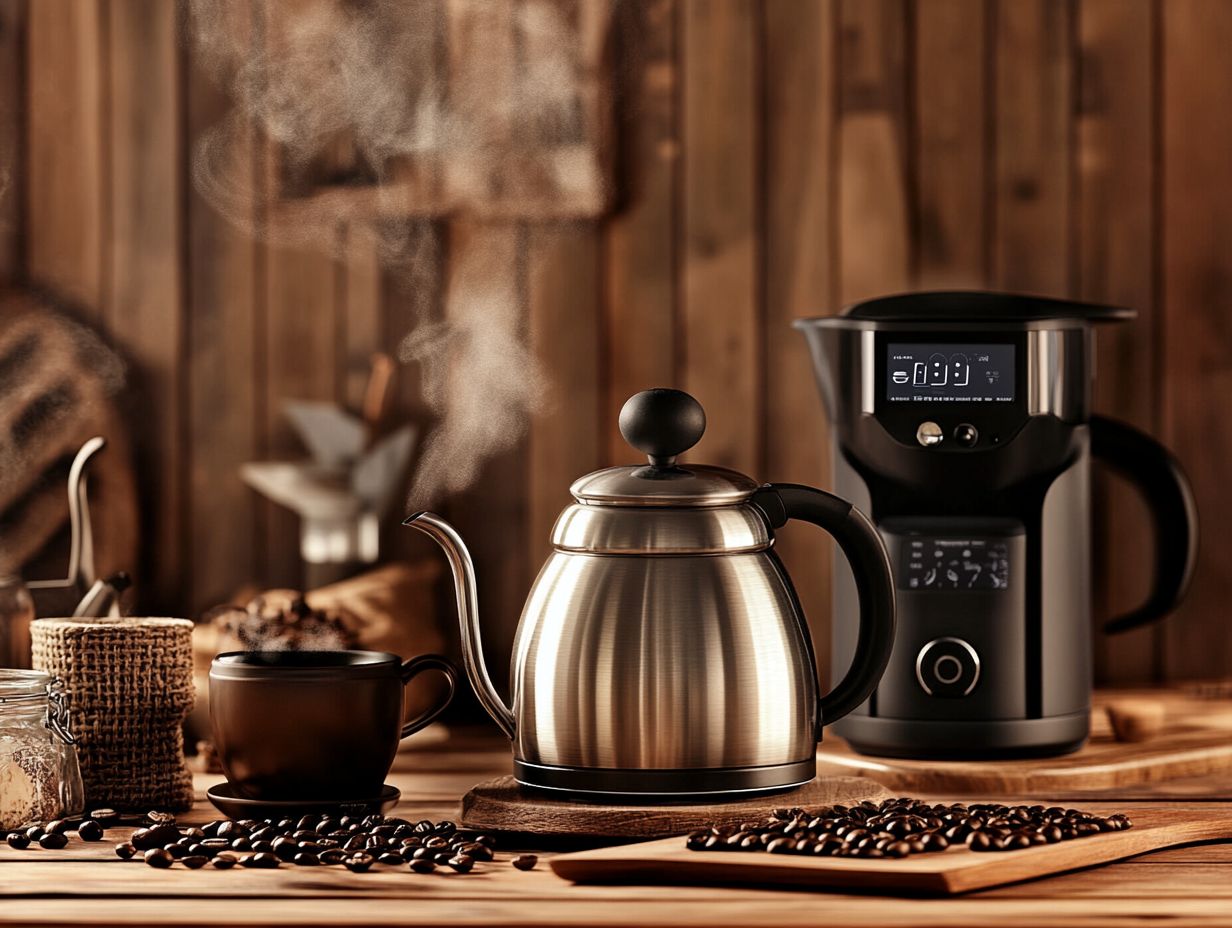
Think of insulated equipment as your brewing superhero! It effectively minimizes heat loss and shields your fermentation environment from those pesky external temperature fluctuations. As a home brewer, you can greatly benefit from insulated fermentation chambers, cozy insulated blankets, or clever DIY solutions like cardboard boxes to keep your fermenters snug and warm.
This strategy ensures your yeast stays active, and the fermentation process unfolds within the optimal temperature range.
By investing in high-quality insulated equipment, you can achieve remarkable temperature stability. This translates to enhanced flavor profiles and a lower risk of fermentation defects. Insulated fermentation chambers not only maintain your desired temperature more effectively but also act as a buffer against temperature spikes during warm weather.
If you re looking for a budget-friendly approach, wrapping your fermenters in insulated blankets can be a smart and cost-effective solution. For those with a knack for creativity, materials like foam boards or even sleeping bags can significantly boost insulation.
No matter which method you choose, keeping the fermentation environment consistent is crucial for the overall success of your home brewing endeavors.
Start implementing these tips today for a perfect brew every time!
4. Control Ambient Temperature
Controlling the ambient temperature is essential for maintaining a stable brewing environment, as any fluctuations in room temperature can directly impact the fermentation process. As a home brewer, you can take advantage of tools like space heaters or swamp coolers to regulate the temperature around your fermentation chambers, ensuring that the yeast stays within its optimal temperature range. Clever temperature hacks, such as using frozen water bottles or wet towels, can also help keep the environment within your desired parameters, leading to better fermentation results.
Utilizing temperature controllers can significantly refine the precision of your brewing conditions. These devices allow you to program a specific temperature, automatically activating heating or cooling elements as needed, which provides a consistent environment for yeast activity.
Additionally, insulating your fermentation vessels with blankets or foam can help minimize temperature swings, further optimizing yeast performance. Monitoring tools like thermometers and hygrometers give you the power to collect data on your surroundings, enabling you to make informed adjustments.
By incorporating these strategies, you can create an ideal habitat for your yeast, ultimately leading to exceptional flavor profiles in your beer.
Tips for Maintaining Consistent Brewing Temperatures
To ensure consistent brewing temperatures and elevate the quality of your beer, you can employ several practical tips and strategies throughout your brewing journey. One essential piece of advice is to utilize fresh, high-quality water; the quality of your brewing water plays a significant role in influencing fermentation and flavor profiles.
Moreover, storing your brewing equipment in a cool, dry location, such as a used refrigerator or insulated chamber, will help prevent temperature fluctuations during the brewing process, thereby maintaining a stable fermentation environment that is most favorable for yeast activity.
1. Use Fresh, High-Quality Water for Home Brewing
Using fresh, high-quality water in your brewing process is absolutely essential for achieving optimal fermentation results and elevating the quality of your beer. The characteristics of your water like its mineral content and pH can have a remarkable impact on yeast activity and the overall flavor profile of your brew. As a home brewer, you should prioritize sourcing quality water to create a conducive fermentation environment and enhance your final product. Consider exploring brewing tips and techniques from the brewing community to further refine your methods.
By thoughtfully selecting water that is free from impurities and balancing minerals such as calcium, magnesium, and sulfate, you lay a strong foundation for your creations. This is vital, as the right mineral balance can amplify specific flavors and aromas, allowing the unique characteristics of your chosen malt and hops to truly shine. Additionally, adjusting your water chemistry can be a part of your DIY brew process, making your home brewing experience even more personalized.
Adjusting the pH levels of your brewing water can promote healthier yeast fermentation, leading to a cleaner taste. To achieve the highest quality, it’s wise to test your water for any off-flavors or unwanted chemicals. Consider using filtration systems or sourcing your water from trusted providers. Tools like digital pH meters can offer precise control over your water’s characteristics, which is essential for maintaining temperature consistency during fermentation.
Understanding the intricate relationship between water quality, fermentation, and the overall brewing process gives you the power to craft more refined and delicious beers. This knowledge also helps you make informed decisions when considering fermentation upgrades & brewing methods to improve your brewing outcomes.
2. Store Equipment in a Cool, Dry Place
Storing your brewing equipment in a cool, dry place is essential for maintaining consistent temperatures and preventing unwanted fluctuations during the brewing process. By keeping your equipment shielded from direct sunlight and heat sources, you can create a stable fermentation environment.
This practice not only safeguards the integrity of your brewing gear but also enhances temperature control throughout fermentation. Using a fermentation chamber or a swamp cooler will elevate the quality of your beer like never before!
Investing in proper storage solutions, such as temperature-controlled cabinets or insulated bins, can greatly improve the quality of your final product. Each specific style of beer may demand slightly different fermentation temperatures, and maintaining these optimal conditions is crucial for achieving those desired flavor profiles.
For homebrewers on a budget, alternatives like a Rubbermaid tub or even a cardboard box with insulation can be effective.
When you think about storage, it s important to prioritize cleanliness to avoid contamination, which can compromise the quality of your beer. Using airtight containers for your grains and hops, along with regularly checking the temperature of your fermentation tanks, can significantly improve your overall brewing experience, ensuring that the results are both satisfying and delicious.
To maintain optimal temperatures in your fermentation chamber, consider methods like ice packs, heating belts, or electric heaters as needed.
3. Follow Brewing Recipes and Instructions for Better Beer Quality
Following brewing recipes and instructions closely is crucial for you to maintain consistent brewing temperatures and ensure successful fermentation. Recipes typically provide specific temperature ranges and guidelines tailored to particular yeast strains and beer styles.
By adhering to these instructions, you set yourself up for success and steer clear of potential pitfalls that could detract from your beer’s quality. Joining the brewing community can also provide valuable insights and advice for improving your brewing techniques.
Understanding the nuances of each recipe not only helps you achieve the desired flavor profile but also plays a significant role in fermentation stability. Yeast activity can be quite sensitive to temperature fluctuations, and sticking to the specified ranges helps you avoid those undesirable off-flavors.
New homebrewers can gain a lot from detailed brewing logs and temperature control methods, such as using a digital temperature controller.
To interpret and apply the instructions effectively, take the time to read through recipes thoroughly in advance, paying attention to any unique requirements. Maintaining accurate temperature control using reliable equipment or methods can elevate your brewing from a simple hobby to a consistently rewarding practice.
Tools like a digital temperature controller or fermentation heater can help you maintain the necessary conditions for optimal fermentation.
Keeping a detailed brewing log helps you fine-tune your techniques for future batches. Documenting the use of different brewing methods and equipment like a kegerator or keezer can help in identifying what works best for your brewing needs.
Start logging your brewing processes today for the best results!
4. Clean and Maintain Brewing Equipment Regularly
Regularly cleaning and maintaining your brewing equipment is essential for achieving high-quality beer and ensuring optimal fermentation temperatures. Residue buildup can compromise the performance of your fermentation vessels, leading to temperature inconsistencies and potential flavor contamination.
To preserve the integrity of your brewing process and enhance the overall quality of your beer, establish a routine for cleaning and maintaining your equipment. This is particularly crucial when fermenting in a carboy or other fermentation vessels that require precise control over the fermentation environment.
By incorporating a detailed cleaning schedule one that includes sanitizing fermentation tanks immediately after use and regularly inspecting hoses and fittings for signs of wear you can significantly reduce the risk of off-flavors and infections. Regular checks on your temperature control mechanisms, such as thermometers and chillers, will help maintain consistent fermentation conditions, which are crucial for developing the desired flavors and aromas in your beer.
If you’re using an insulated blanket or swamp cooler, make sure they are also kept clean to prevent any contamination.
Consider using no-rinse sanitizers and vinegar for cleaning to streamline your maintenance process. Incorporating cold crashing techniques, which involves rapidly cooling beer to clarify it, can enhance the clarity and quality of your drink.
Regular maintenance not only keeps your brewing equipment in top shape, but it also boosts the quality of your beer, making every sip more enjoyable! Consistent maintenance extends the lifespan of your equipment and elevates the overall brewing experience.
Frequently Asked Questions
What is the importance of maintaining consistent brewing temperatures?
Consistent brewing temperatures are crucial for producing high-quality and consistent results in your brewed beverage. Fluctuations in temperature can lead to varying levels of extraction and affect the overall taste and aroma of your drink.
What are some factors that can affect brewing temperatures for home brewing?
Ambient temperature, altitude, and equipment variations can all contribute to variations in brewing temperatures. It’s important to monitor and adjust these factors to maintain consistency. Techniques like using frozen water bottles or a wet towel can help manage temperature fluctuations effectively.
How can I monitor and control brewing temperatures in my fermentation environment?
Investing in a reliable and accurate thermometer is crucial for monitoring brewing temperatures. Additionally, regularly calibrating your equipment and checking for any environmental factors can help maintain control over temperatures.
What are some techniques for maintaining consistent brewing temperatures during the fermentation process?
Preheating your equipment, controlling the rate of water flow, and using insulating materials can all help maintain consistent brewing temperatures. It’s also important to regularly clean and maintain your equipment to ensure proper functioning. For more advanced temperature control, consider using a fermentation heater or a space heater in your brewing area.
What are the consequences of not maintaining consistent brewing temperatures?
Inconsistent brewing temperatures can result in off-flavors, weak or bitter taste, and even equipment damage. It can also impact the overall consistency and quality of your brewed beverage.
How often should I check and adjust brewing temperatures?
For optimal results, it’s recommended to check and adjust brewing temperatures for each batch of brewed beverage. This will help ensure consistency and produce the best possible flavor and aroma in your drink.

